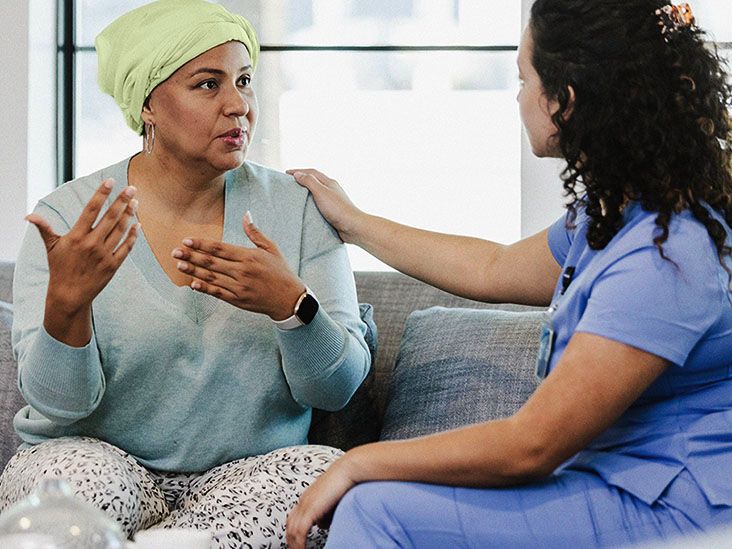Hair loss related to chemotherapy for breast cancer can compound distress around a breast cancer diagnosis. Black females may find that cooling caps and other hair loss coping strategies are less effective than for people with non-textured hair.
A note about sex and gender
Sex and gender exist on spectrums. This article will use the terms “male,” “female,” or both to refer to sex assigned at birth. Learn more.
Chemotherapy can have a number of undesirable side effects, including a type of hair loss (alopecia) called chemotherapy-induced alopecia (CIA). While CIA can affect anyone, its severity and how well traditional coping methods work can vary based on a person’s race or ethnicity.
A
Treatment resistance is just one challenge Black females with CIA face. The 2023 literature review also points out that cranial prostheses (custom-made, prescription hairpieces and wigs) for people with breast cancer aren’t as readily available to match textured hairstyles.
This article takes an in-depth look at hair loss and breast cancer among Black females and alternative methods for coping with CIA.
Treatments for CIA can include scalp cooling systems, topical agents, oral medications, and several other therapies, such as platelet-rich plasma infections.
A
The treatment involves a person wearing a silicone hat connected to a device that circulates a liquid coolant. The cap lowers the scalp’s temperature, which promotes vasoconstriction, or narrowing of the blood vessels that supply the hair follicles. Smaller vessels decrease circulation, meaning less of the chemotherapy drug can reach the follicle to cause damage.
A 2023 review indicates that scalp cooling systems have an average success rate between 50% and 70%, depending on the CIA treatment regime.
Studies investigating racial differences in CIA treatment are limited, but several investigations have looked into the effectiveness of scalp cooling among Black females.
A 2022 literature review indicates that CIA is more likely to progress despite scalp cooling, and hair loss is more likely to be permanent in Black females.
While experts are unsure about why this disparity exists, a case report from 2024 suggests some of the outcome differences for Black females with CIA may have to do with how textured hair prevents scalp cooling caps from sitting as close to the scalp as they do on smoother, finer hair textures.
Scalp cooling does not work for everyone, and it may be even less likely to work for Black females. If scalp cooling is ineffective, several other treatment options exist.
Find Black-focused cranial prostheses
Custom-made wigs and hairpieces for people with non-textured hair are in ready supply, but finding ones that appeal to Black hairstyles can be more challenging. However, for people who wish to utilize cranial protheses, companies focused on Black people are becoming more mainstream, including:
Take excellent care of existing hair and scalp
CIA does not always cause complete hair loss. Its severity can vary, and a person may only lose patches of hair or lose hair across one section of their scalp.
With CIA, new hair growth and any remaining hair can be fragile, and some styling options, such as straighteners, dyes, cornrows, or tight braids,
A gentle shampoo and conditioner can help protect hair from exposure to drying or abrasive chemicals. To prevent sun damage to hair follicles, cover areas of the exposed scalp and use sunscreen with an SPF of 30 or higher.
Embrace new style options
CIA can take away a defining feature of a person’s individuality. While wigs and hairpieces can often resemble a person’s hairstyle before they developed CIA, these are just one of several style options. Other options include scarves, hats, and bonnets. A person can change these easily to match their outfits or moods, for example. Some people may find them more comfortable than wigs.
Find a creative hairstylist
Visit a hairstylist who has experience working with females with hair loss due to chemotherapy for breast cancer. Hairstylists can help a person discover new styles, such as a shorter cut or a new look. Experienced stylists have in-depth knowledge of what can work for each individual.
CIA can take an emotional toll, but it is important to remember that hair can grow back after chemotherapy treatment
It is always OK to speak with a mental health professional if feelings of hopelessness, anxiety, or low self-esteem are affecting everyday life. Therapists can provide additional insight into coping strategies and can help a person restructure unhelpful patterns of thinking and behaving that can contribute to negative feelings about CIA.
Black females may be more likely to experience severe and permanent CIA during breast cancer chemotherapy, and traditional hair preservation options, such as scalp cooling, may not be as effective.
Black-focused cranial protheses, new style choices, and diligent hair and scalp care can help Black females cope when scalp cooling and other hair loss coping strategies are ineffective.




